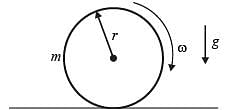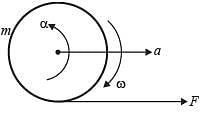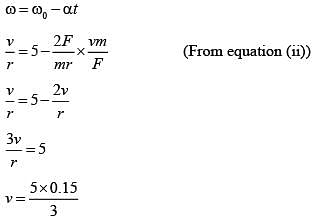Mechanical Engineering Exam > Mechanical Engineering Questions > A cylindrical disc of mass m = 1 kg and radiu...
Start Learning for Free
A cylindrical disc of mass m = 1 kg and radius r = 0.15 m was spinning at ω = 5 rad/s when it was placed on a flat horizontal surface and released (refer to the figure). Gravity g acts vertically downwards as shown in the figure. The coefficient of friction between the disc and the surface is finite and positive.
Disregarding any other dissipation except that due to friction between the disc and the surface, the horizontal velocity of the center of the disc, when it starts rolling without slipping, will be _________ m/s (round off to 2 decimal places).

Disregarding any other dissipation except that due to friction between the disc and the surface, the horizontal velocity of the center of the disc, when it starts rolling without slipping, will be _________ m/s (round off to 2 decimal places).

Correct answer is '0.25'. Can you explain this answer?
| FREE This question is part of | Download PDF Attempt this Test |
Most Upvoted Answer
A cylindrical disc of mass m = 1 kg and radius r = 0.15 m was spinning...
Given data :
Mass of cylindrical disc (m) = 1 kg
Radius of disc (r) = 0.15 m
Initial angular velocity of disc (ω0 )= 5 rad/s
Gravitational acceleration = g (m/s2)

Let us horizontal velocity of disc = v m/s

We know, Newton’s second law for linear motion F = ma … (i)
And Newton’s second law for angular motion
Mass of cylindrical disc (m) = 1 kg
Radius of disc (r) = 0.15 m
Initial angular velocity of disc (ω0 )= 5 rad/s
Gravitational acceleration = g (m/s2)

Let us horizontal velocity of disc = v m/s

We know, Newton’s second law for linear motion F = ma … (i)
And Newton’s second law for angular motion

Newton’s 1st law of motion, for linear motion
v = u+ at [ u = 0 , because when disc touches the ground initial velocity will be zero]

Newton’s 1st law of motion for angular motion

v = 0.25 m/s
Hence, the correct answer is 0.25.
Attention Mechanical Engineering Students!
To make sure you are not studying endlessly, EduRev has designed Mechanical Engineering study material, with Structured Courses, Videos, & Test Series. Plus get personalized analysis, doubt solving and improvement plans to achieve a great score in Mechanical Engineering.

|
Explore Courses for Mechanical Engineering exam
|

|
Similar Mechanical Engineering Doubts
A cylindrical disc of mass m = 1 kg and radius r = 0.15 m was spinning at ω = 5 rad/s when it was placed on a flat horizontal surface and released (refer to the figure). Gravity g acts vertically downwards as shown in the figure. The coefficient of friction between the disc and the surface is finite and positive.Disregarding any other dissipation except that due to friction between the disc and the surface, the horizontal velocity of the center of the disc, when it starts rolling without slipping, will be _________ m/s (round off to 2 decimal places).Correct answer is '0.25'. Can you explain this answer?
Question Description
A cylindrical disc of mass m = 1 kg and radius r = 0.15 m was spinning at ω = 5 rad/s when it was placed on a flat horizontal surface and released (refer to the figure). Gravity g acts vertically downwards as shown in the figure. The coefficient of friction between the disc and the surface is finite and positive.Disregarding any other dissipation except that due to friction between the disc and the surface, the horizontal velocity of the center of the disc, when it starts rolling without slipping, will be _________ m/s (round off to 2 decimal places).Correct answer is '0.25'. Can you explain this answer? for Mechanical Engineering 2024 is part of Mechanical Engineering preparation. The Question and answers have been prepared according to the Mechanical Engineering exam syllabus. Information about A cylindrical disc of mass m = 1 kg and radius r = 0.15 m was spinning at ω = 5 rad/s when it was placed on a flat horizontal surface and released (refer to the figure). Gravity g acts vertically downwards as shown in the figure. The coefficient of friction between the disc and the surface is finite and positive.Disregarding any other dissipation except that due to friction between the disc and the surface, the horizontal velocity of the center of the disc, when it starts rolling without slipping, will be _________ m/s (round off to 2 decimal places).Correct answer is '0.25'. Can you explain this answer? covers all topics & solutions for Mechanical Engineering 2024 Exam. Find important definitions, questions, meanings, examples, exercises and tests below for A cylindrical disc of mass m = 1 kg and radius r = 0.15 m was spinning at ω = 5 rad/s when it was placed on a flat horizontal surface and released (refer to the figure). Gravity g acts vertically downwards as shown in the figure. The coefficient of friction between the disc and the surface is finite and positive.Disregarding any other dissipation except that due to friction between the disc and the surface, the horizontal velocity of the center of the disc, when it starts rolling without slipping, will be _________ m/s (round off to 2 decimal places).Correct answer is '0.25'. Can you explain this answer?.
A cylindrical disc of mass m = 1 kg and radius r = 0.15 m was spinning at ω = 5 rad/s when it was placed on a flat horizontal surface and released (refer to the figure). Gravity g acts vertically downwards as shown in the figure. The coefficient of friction between the disc and the surface is finite and positive.Disregarding any other dissipation except that due to friction between the disc and the surface, the horizontal velocity of the center of the disc, when it starts rolling without slipping, will be _________ m/s (round off to 2 decimal places).Correct answer is '0.25'. Can you explain this answer? for Mechanical Engineering 2024 is part of Mechanical Engineering preparation. The Question and answers have been prepared according to the Mechanical Engineering exam syllabus. Information about A cylindrical disc of mass m = 1 kg and radius r = 0.15 m was spinning at ω = 5 rad/s when it was placed on a flat horizontal surface and released (refer to the figure). Gravity g acts vertically downwards as shown in the figure. The coefficient of friction between the disc and the surface is finite and positive.Disregarding any other dissipation except that due to friction between the disc and the surface, the horizontal velocity of the center of the disc, when it starts rolling without slipping, will be _________ m/s (round off to 2 decimal places).Correct answer is '0.25'. Can you explain this answer? covers all topics & solutions for Mechanical Engineering 2024 Exam. Find important definitions, questions, meanings, examples, exercises and tests below for A cylindrical disc of mass m = 1 kg and radius r = 0.15 m was spinning at ω = 5 rad/s when it was placed on a flat horizontal surface and released (refer to the figure). Gravity g acts vertically downwards as shown in the figure. The coefficient of friction between the disc and the surface is finite and positive.Disregarding any other dissipation except that due to friction between the disc and the surface, the horizontal velocity of the center of the disc, when it starts rolling without slipping, will be _________ m/s (round off to 2 decimal places).Correct answer is '0.25'. Can you explain this answer?.
Solutions for A cylindrical disc of mass m = 1 kg and radius r = 0.15 m was spinning at ω = 5 rad/s when it was placed on a flat horizontal surface and released (refer to the figure). Gravity g acts vertically downwards as shown in the figure. The coefficient of friction between the disc and the surface is finite and positive.Disregarding any other dissipation except that due to friction between the disc and the surface, the horizontal velocity of the center of the disc, when it starts rolling without slipping, will be _________ m/s (round off to 2 decimal places).Correct answer is '0.25'. Can you explain this answer? in English & in Hindi are available as part of our courses for Mechanical Engineering.
Download more important topics, notes, lectures and mock test series for Mechanical Engineering Exam by signing up for free.
Here you can find the meaning of A cylindrical disc of mass m = 1 kg and radius r = 0.15 m was spinning at ω = 5 rad/s when it was placed on a flat horizontal surface and released (refer to the figure). Gravity g acts vertically downwards as shown in the figure. The coefficient of friction between the disc and the surface is finite and positive.Disregarding any other dissipation except that due to friction between the disc and the surface, the horizontal velocity of the center of the disc, when it starts rolling without slipping, will be _________ m/s (round off to 2 decimal places).Correct answer is '0.25'. Can you explain this answer? defined & explained in the simplest way possible. Besides giving the explanation of
A cylindrical disc of mass m = 1 kg and radius r = 0.15 m was spinning at ω = 5 rad/s when it was placed on a flat horizontal surface and released (refer to the figure). Gravity g acts vertically downwards as shown in the figure. The coefficient of friction between the disc and the surface is finite and positive.Disregarding any other dissipation except that due to friction between the disc and the surface, the horizontal velocity of the center of the disc, when it starts rolling without slipping, will be _________ m/s (round off to 2 decimal places).Correct answer is '0.25'. Can you explain this answer?, a detailed solution for A cylindrical disc of mass m = 1 kg and radius r = 0.15 m was spinning at ω = 5 rad/s when it was placed on a flat horizontal surface and released (refer to the figure). Gravity g acts vertically downwards as shown in the figure. The coefficient of friction between the disc and the surface is finite and positive.Disregarding any other dissipation except that due to friction between the disc and the surface, the horizontal velocity of the center of the disc, when it starts rolling without slipping, will be _________ m/s (round off to 2 decimal places).Correct answer is '0.25'. Can you explain this answer? has been provided alongside types of A cylindrical disc of mass m = 1 kg and radius r = 0.15 m was spinning at ω = 5 rad/s when it was placed on a flat horizontal surface and released (refer to the figure). Gravity g acts vertically downwards as shown in the figure. The coefficient of friction between the disc and the surface is finite and positive.Disregarding any other dissipation except that due to friction between the disc and the surface, the horizontal velocity of the center of the disc, when it starts rolling without slipping, will be _________ m/s (round off to 2 decimal places).Correct answer is '0.25'. Can you explain this answer? theory, EduRev gives you an
ample number of questions to practice A cylindrical disc of mass m = 1 kg and radius r = 0.15 m was spinning at ω = 5 rad/s when it was placed on a flat horizontal surface and released (refer to the figure). Gravity g acts vertically downwards as shown in the figure. The coefficient of friction between the disc and the surface is finite and positive.Disregarding any other dissipation except that due to friction between the disc and the surface, the horizontal velocity of the center of the disc, when it starts rolling without slipping, will be _________ m/s (round off to 2 decimal places).Correct answer is '0.25'. Can you explain this answer? tests, examples and also practice Mechanical Engineering tests.

|
Explore Courses for Mechanical Engineering exam
|

|
Suggested Free Tests
Signup for Free!
Signup to see your scores go up within 7 days! Learn & Practice with 1000+ FREE Notes, Videos & Tests.
























